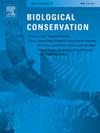Global priorities for developing higher education capacity in biodiversity conservation
IF 4.9
1区 环境科学与生态学
Q1 BIODIVERSITY CONSERVATION
引用次数: 0
Abstract
Despite the recognized need to address global inequalities in conservation research, there has been little effort to understand and address the concomitant lack of higher education capacity in biodiversity conservation, particularly in the Global South. This hampers international efforts to meet goals in conservation planning, policy, and practice, including those defined by the Kunming-Montreal Global Biodiversity Framework. In this study, we surveyed universities and conservation practitioners across 48 priority countries – those with high conservation value, moderate education index, and low-to-moderate research productivity – to assess the global status and needs of higher education in biodiversity conservation. Our results highlight substantial opportunity to develop educational capacity where it is most needed, with 44 % of priority countries (61 % of universities) lacking any degree programs focused on biodiversity conservation, and 93 % of survey respondents wishing to strengthen or expand their curricula. The lack of educational opportunities was the main factor cited for why half of the surveyed conservation practitioners pursued their education abroad, and why 55 % believe that the educational offerings in their country are insufficient to train the next generation of conservation leaders. Survey results were remarkably consistent in describing how the broader conservation community can best support the development of educational capacity in priority countries: pursue collaborative research and knowledge exchange, expand internship and job opportunities, and improve student funding. These actions will require the initiative and resources of external partners, including conservation NGOs, government agencies, international researchers, and other universities. Developing this capacity merits conscientious effort from the global conservation community.
发展生物多样性保护高等教育能力的全球优先事项
尽管认识到有必要解决保护研究中的全球不平等问题,但在理解和解决随之而来的生物多样性保护高等教育能力缺乏方面的努力很少,特别是在全球南方。这阻碍了国际社会在保护规划、政策和实践方面的努力,包括《昆明-蒙特利尔全球生物多样性框架》所定义的目标。在本研究中,我们调查了48个生物多样性保护价值高、教育指数中等、研究生产力中低的优先国家的大学和保护从业者,以评估高等教育在生物多样性保护方面的全球现状和需求。我们的结果强调了在最需要的地方发展教育能力的巨大机会,44%的优先国家(61%的大学)缺乏任何专注于生物多样性保护的学位课程,93%的调查受访者希望加强或扩大他们的课程。缺乏教育机会是被调查的保护从业者中有一半在国外接受教育的主要原因,也是55%的人认为本国的教育不足以培养下一代保护领导人的主要原因。调查结果非常一致地描述了更广泛的保护社区如何最好地支持优先国家的教育能力发展:追求合作研究和知识交流,扩大实习和就业机会,以及改善学生资助。这些行动需要外部合作伙伴的倡议和资源,包括保护非政府组织、政府机构、国际研究人员和其他大学。发展这种能力需要全球环境保护界的认真努力。
本文章由计算机程序翻译,如有差异,请以英文原文为准。
求助全文
约1分钟内获得全文
求助全文
来源期刊

Biological Conservation
环境科学-环境科学
CiteScore
10.20
自引率
3.40%
发文量
295
审稿时长
61 days
期刊介绍:
Biological Conservation is an international leading journal in the discipline of conservation biology. The journal publishes articles spanning a diverse range of fields that contribute to the biological, sociological, and economic dimensions of conservation and natural resource management. The primary aim of Biological Conservation is the publication of high-quality papers that advance the science and practice of conservation, or which demonstrate the application of conservation principles for natural resource management and policy. Therefore it will be of interest to a broad international readership.
 求助内容:
求助内容: 应助结果提醒方式:
应助结果提醒方式:


